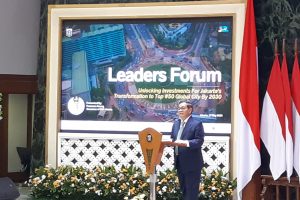
MORE than two decades (23 years), the Bank Indonesia Liquidity Assistance (BLBI) issue is similar to a continuing saga. There have been six governments – the BLBI story is still far from over. Since the Soeharto government to President Joko Widodo, BLBI’s “Soap Operas” has become more and more interesting with various spices and seasonings. In fact, the cost of the 1917/1998 crisis has been paid by bank and economy improvement after the monetary crisis. One of the contributors to fill the state treasury is BRI.
By Eko B. Supriyanto, Chief Editor of Infobank Media Group
There are too many seasonings. So, the essence of the BLBI policy objective and the recap bond issuance to revive the banks is gone. Also, to encourage and restore a negative economy. The origin of BLBI policy is meant for handling the crisis, therefore banks come back to life, provide credit, and revive the real sector. Also, there is labor absorbed and in the end a tax for the state.
Imagine if there was no BLBI policy and recap bonds. Of course, Indonesia does not have Himbara banks. The four state-owned banks, namely BRI, BNI, BTN, and Mandiri, are crisis products with recap bonds. It’s true, the four banks were not getting any BLBI, but they swallowed a considerable amount of recap bonds. The figure is Rp282.319 trillion to revive the four state-owned banks.
Private banks were also flooded with BLBI and recap bonds. A number of regional development banks (BPD) also swallowed recap bonds. If there is no BLBI policy and recap bonds, Indonesia will not have BCA, Danamon, CIMB Niaga, Maybank, and PermataBank. Also, we don’t have Bank DKI, Bank Jateng, Bank Jatim, and a number of other BPDs.
The BLBI policy and recap bonds kept the banks from being closed, providing credit, reviving the real sector, the economy was moving, and taxes paid to the state also increased. There are dividends and there are taxes paid for state-owned banks. For the private sector, the bank pays, the shareholders also pay taxes – both those arising from dividend taxes and taxes from salaried employees.
Crisis handling policies cannot be seen from how much profit and loss made, similar to a grocery trader. For example, if the state has spent Rp647.13 trillion, then it must return Rp647.13 trillion, plus interest. The main point is how to minimize the cost of dealing with the crisis.
Every crisis has a cost – but of course the costs can be accounted for. Policies cannot be criminalized and politicized. And, if there are stowaways in the policy, it’s a different story. The BLBI handling and recap bonds are clear. Those who are cooperative and have a certificate of full payment (SKL) are considered to be in order. Those who are uncooperative and fugitive are going to jail. That’s it.
BRI Already Contributed Rp556.3 Trillion
Since the 1997/1998 monetary crisis, the BLBI policy and recap bonds have always been told from the dark side. In fact, observers or Indonesian House of Representatives members who were still in junior high school during the BLBI era also commented on the BLBI policy and recap bonds. It is rare for anyone to talk about the results of the 1997/1998 crisis management policies.
According to Infobank Institute records and data from the Infobank Research Bureau, in handling the crisis by the National Bank Restructuring Agency (BPPN), Asset Management Companies (PPA) and contributions from banks that were recaptured and taken over, to be honest, the crisis cost of Rp647.13 trillion was actually already back. If we use the Supreme Audit Agency (BPK) records, the crisis cost is not that big, but Rp. 621.44 trillion – of course, the calculations are even higher. It could be, according to the Infobank Institute’s records, the difference occurred because there was an excess of the returned recap bonds.
By the time BPPN (2004) closed, and the remaining assets were handed over to PPA and the Directorate General of State Assets (DJKN), BPPN had already contributed Rp188 trillion to finance the APBN. And, BPPN plus PPA deposits of Rp208 trillion. Or, 33% of the crisis costs recorded by BPK. In line with that, until now, the recapitulated banks also have contributed in filling the state treasury.
In fact, one example is BRI’s contribution – from when it was recapitulated at Rp29.13 trillion to the rights issue, it is the only bank that has contributed almost twice the cost of a state-owned bank recapitulation. Or to be precise, more than 197% of all recap bonds were disbursed to all state-owned banks (BRI, Mandiri, BNI, and BTN). When compared to the cost of its own recap, BRI has returned almost 20 times more.
The amount of recapitalization bonds disbursed was Rp282.319 trillion to revive the four state-owned banks. Meanwhile, BRI’s contribution since the crisis until now has reached Rp556.3 trillion. When compared to the entire cost of the crisis according to BPK’s version (Rp. 621.44 trillion), BRI actually contributed 90% of the crisis total cost. Of course, it’s different if we take into account BRI’s contribution in 2021. It’s remarkable.
How to calculate it? The calculations are based on the sum of dividends, taxes paid to the state treasury and BRI’s market capitalization. If recapitalization was not carried out in 1999, we would no longer have BRI, or even have to close it because of its low capital adequacy ratio (CAR), under BI regulations. The government also chose to revive BRI through recap bonds.
According to the Infobank Institute, since 1999-2020, or since the recap, BRI has contributed dividends and taxes to the state treasury of Rp193.6 trillion. In fact, in the last four years, 2017-2020, taxes and dividends paid by BRI reached Rp101.56 trillion. It is increasing every year.
Meanwhile, the government’s ownership in BRI is 56.815%, and currently BRI’s market capitalization reaches Rp. 638.38 trillion. So, from this ownership alone, the government has shares worth Rp362.7 trillion. If it is added with dividends and taxes that have been deposited into the state treasury of Rp193.6 trillion, then the total contribution of BRI is Rp556.3 trillion.
This also means that BRI has contributed to the 1997/1998 crisis cost recovery, around 90% from Rp621.44 trillion. That’s a minimal contribution. If we re-calculate the taxes paid by employees and debtors, the amount that BRI can turn on for sure is even higher.
If it is related to the crisis cost, although it is not directly related, it only emphasizes that the cost of handling the crisis can be seen from the improvement in banks, the contribution of the economy to the economy and tax revenues.
The Fenomenal Right Issue
We have to admit, after 22 years of recapitulation, BRI has become a giant. Especially after the rights issue with a massive value of Rp95.9 trillion, which consists of Rp54.7 trillion in the form of government participation in Pegadaian and Permodalan Nasional Madani (PNM) shares. The remaining Rp41.2 trillion is in the form of cash proceeds from public shareholders.
The BRI right issue achievement made history, the largest in Southeast Asia, occupying the third position in Asia’s rights issue and the seventh largest in the world. It is known that 28 billion shares issued in BRI’s rights issue have been fully absorbed, and have even been oversubscribed by 153%.
According to Sunarso, President Director of BRI, to achieve inorganic growth and value creation during the COVID-19 pandemic, BRI has taken at least three major corporate steps. One, to consolidate with Bank Syariah Indonesia (BSI) – where the valuation of BRI Syariah shares has increased more than four times compared to before the consolidation.
Two, establishing a subsidiary in the field of life insurance, BRI Life. Currently (2021) the valuation of BRI Life has increased to Rp7.5 trillion – where previously BRI acquired BRI Life for Rp1.6 trillion in 2015. Apart from that, BRI still gets extra cash in the form of an access fee of Rp4.4 trillion which will be paid in stages over the period 2021-2024.
Three, as explained by Sunarso, BRI has taken corporate actions, namely increasing capital through a rights issue in the formation of the Ultra Micro ecosystem – a phenomenal amount of Rp95.9 trillion. Ultra Micro Holding, Sunarso emphasized, will become a new source of growth and encourage economic growth.
In line with BRI’s mission to become The Most Valuable Banking Group in Southeast Asia & Champion of Financial Inclusion, BRI continues to develop its business in a sustainable manner. It can be inorganic or organic, including ownership in Bank Agro (Bank Raya) – whose vision is to become the largest digital bank in Indonesia. It is estimated that, in the future, Bank Raya as a digital bank will give high value to BRI (market capitalization continues to increase).
In fact, as stated by Sunarso, the value creation process does not only contribute to the economy, but also contributes to the state treasury. However, his dream is also, one day, at least 1% of BRI shares can be owned by all BRILian people – BRI employees. All of this is good for the culture of all employees so that they continue to create value for the company to move forward.
During the 22 years of BRI’s journey after being recaptured with five president directors, Rudjito, Sofyan Basir, Asmawi Sjam, Suprajarto and Sunarso, BRI has now become a giant conglomeration of the financial sector with assets of Rp1,450.9 trillion (June 2021). When recapitulated in 2021, BRI’s assets were only Rp31.014 trillion or have gone up more than 47 times. Since 2017, BRI has become the bank with the largest assets.
Moreover, BRI is the bank with the largest contribution to the state treasury. Since 16 years ago, BRI has always won profit competition in the Indonesian banking sector. The move after the rights issue by becoming an Ultra Micro holding, some economists predict, will grow and contribute to the economy. Its assets will organically increase with increased profit with the developed value creation strategy.
Imagine! According to the Infobank Institute’s records, since 1999 until the end of 2020 (21 years), BRI has made a profit of Rp290.51 trillion. Moreover, Rp556.3 trillion is BRI’s contribution since it was recorded at Rp29.13 trillion in 1999. Or, BRI’s contribution is almost double the total cost of state banks recapitulation. Or, close to 90% of the total cost of the 1997/1998 monetary crisis including BLBI issued by the state. And, if you use the 2021 financial statements, don’t be surprised that the entire cost of the monetary crisis has almost certainly been covered by BRI itself. Mind-blowing!




